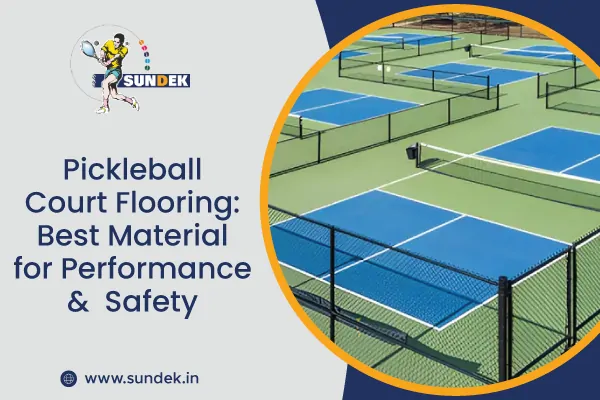Pickleball has rapidly gained popularity across the globe, becoming a favored sport for people of all ages. Whether played recreationally or competitively, a high-quality pickleball court is essential for optimal performance and safety. One of the most critical factors in creating a successful court is selecting the right flooring material. The flooring affects everything from ball bounce to player safety, making it vital to choose a material that ensures excellent performance and minimizes injury risks. This blog will help you navigate the options available and choose the best pickleball court flooring material for your needs.
Importance of Pickleball Court Flooring Material
The flooring of a pickleball court plays a significant role in the game. It influences the speed and bounce of the ball, which directly affects the gameplay and performance. The right flooring material also impacts player comfort and safety. Proper traction prevents accidents, while shock-absorbing properties reduce strain on the body, particularly the joints, which can be vulnerable during high-impact sports. Therefore, when selecting a flooring material, it’s crucial to consider not only performance but also safety and longevity.
Key Factors to Consider When Selecting Court Flooring Material
Durability: The flooring material must withstand frequent foot traffic, weather conditions, and impact from the ball.
Traction: Proper traction ensures players have a firm grip, minimizing the risk of slipping.
Shock Absorption: Good shock absorption minimizes the impact on players’ joints, especially during fast movements and high-intensity play.
Cost: It’s essential to balance budget with the quality and durability of the flooring material.
Maintenance: Some materials may require more maintenance than others, which could affect long-term costs.

Types of Court Flooring Materials
Asphalt
Pros: Asphalt is a cost-effective option for pickleball courts, providing a solid, durable surface that can handle heavy use. It performs well and is quite easy to maintain.
Cons: Asphalt can crack over time due to weather changes, and the surface might become rough if not maintained properly. It may also lack the same level of shock absorption as other materials.
Maintenance: Asphalt requires regular sealing and crack repair to ensure longevity and optimal performance.
Concrete
Pros: Concrete is a strong and low-maintenance flooring choice for pickleball courts. It’s long-lasting and resistant to weather changes. Concrete provides a stable and even playing surface, allowing for predictable ball bounce.
Cons: Concrete may be similarly hard, causing extra joint strain for players. It can also become slippery when wet, making it important to maintain proper drainage around the court.
Maintenance: Concrete courts require periodic resurfacing to maintain smoothness and prevent wear and tear. Sealing helps protect the surface from moisture damage.
Wood
Pros: Wood flooring, often used in indoor pickleball courts, offers an excellent surface for ball bounce and player comfort. It provides a smooth and firm surface with good shock absorption, reducing the risk of joint injuries.
Cons: Wood flooring is susceptible to scratching and wear over time, especially in high-traffic areas. It may also be costly and more challenging to maintain.
Maintenance: Regular cleaning and refinishing are required to maintain the appearance and longevity of the floor. Wood flooring may need to be resealed periodically.
Modular Court Tiles
Pros: Modular tiles are a versatile option for outdoor and indoor pickleball courts. They are easy to install, allowing for quick setup and customization. The tiles offer excellent durability, good traction, and comfort for players. Additionally, they come in various colors and designs.
Cons: While modular tiles are durable, they may not provide the same consistent ball bounce as other materials. If not properly placed, the connections between tiles might loosen with time.
Maintenance: Modular tiles require little maintenance, and individual tiles can be replaced if damaged. They are easy to clean and maintain.
Safety Considerations
Safety is paramount when selecting the right flooring for pickleball courts. A poorly chosen flooring material can increase the risk of slips, falls, and joint strain. For example, concrete can become slippery when wet, while hard surfaces like wood or asphalt can increase the impact on players’ knees and joints. It’s crucial to choose materials that provide adequate traction and shock absorption to minimize injury risks. In addition, the flooring should be free of defects, such as cracks or uneven surfaces, which can cause players to trip or lose balance. Flooring materials that are easy to maintain and clean will also contribute to a safer playing environment, preventing the build-up of debris or slick spots that could lead to accidents.
Choosing the Best Material for Performance & Safety
When selecting the right flooring for your pickleball court, there are several key factors to consider:
Performance Needs: Consider the level of play—recreational, competitive, or professional—and choose a material that provides the ideal ball bounce and traction.
Budget: Evaluate your budget and compare costs for installation and maintenance. While wood and modular tiles may be more expensive initially, their long-term benefits and durability may justify the cost.
Location and Climate: For outdoor courts, the local climate plays a significant role in material choice. Asphalt and concrete work well for outdoor environments, while wood may be better suited for indoor settings.
Maintenance Requirements: Choose a material that fits your ability to maintain it. Some materials, like concrete and asphalt, require less maintenance, while wood flooring may require periodic refinishing.
Player Preferences: Consider how the court will be used and whether the players prefer a softer, more comfortable surface (such as wood) or a firmer, durable one (such as asphalt or concrete).
Why Choose Sundek Sports Private Limited?
Sundek Sports Private Limited is India’s largest manufacturer of high-quality pickleball court flooring. With years of expertise and a reputation for delivering durable and reliable products, they stand out in the industry for their exceptional flooring solutions. Sundek Sports has a wide range of flooring materials to fit the demands of both professional and recreational pickleball players, whether you’re creating an indoor or outdoor court. The company provides a wide selection of flooring options, including modular court tiles, asphalt, concrete, and wood flooring, each designed to ensure optimal performance and safety. Their products are known for their durability, shock absorption, and traction, helping reduce injuries and enhancing player experience. Sundek Sports offers customizable designs, allowing clients to choose the best flooring that suits their specific needs and aesthetic preferences. Sundek Sports is committed to providing excellent customer service and support. They offer expert advice on choosing the right flooring for your pickleball court, ensuring a seamless installation process and long-term durability. Sundek Sports is the top choice for pickleball court flooring that assures exceptional performance, safety, and dependability.
Conclusion
Choosing the right flooring for your pickleball court is an important choice that will impact player performance, safety, and the court’s durability over time. By considering the types of flooring materials—such as asphalt, concrete, wood, and modular tiles—along with key factors like maintenance, cost, and safety, you can ensure that your court provides a safe and enjoyable playing experience. Whether you are building an indoor or outdoor court, prioritizing performance and safety will help ensure that players can enjoy the game without worrying about injury or discomfort. Invest in the right flooring today to create a court that enhances both performance and longevity for your players. If you’re ready to get started with your court flooring, contact Sundek Sports Private Limited for expert advice and top-quality flooring solutions.
Upgrade your pickleball court flooring for optimal performance. Contact us now! Call Now – +91 93203 08938, Email – info@sundek.in.
FAQ
Which flooring is ideal for a pickleball court?
The best flooring for pickleball courts balances durability, shock absorption, and traction. Popular materials include modular court tiles, concrete, wood, and asphalt, each providing different benefits depending on location and use.
Why is flooring important for pickleball courts?
Flooring affects the ball’s bounce, player performance, and safety. Proper flooring ensures consistent play, minimizes injuries, and provides adequate grip, contributing to a better overall pickleball experience.
What are the advantages of asphalt flooring for pickleball courts?
Asphalt is durable and cost-effective, offering a good bounce for the ball. It’s easy to maintain, but it requires sealing over time and may not provide as much shock absorption as other materials.
What are the benefits of concrete flooring for pickleball courts?
Concrete provides a smooth, long-lasting surface with minimal maintenance. However, it can be hard on joints due to less shock absorption. Proper coating helps improve grip and weather resistance.
Is wood flooring suitable for pickleball courts?
Wood flooring offers great ball bounce and smooth play, ideal for indoor courts. It requires more maintenance than outdoor materials but provides superior aesthetics and comfort for players with good shock absorption.
What are modular court tiles, and how do they benefit pickleball courts?
Modular court tiles are easy to install, customizable, and provide shock absorption. They offer good grip and can withstand weather conditions, making them ideal for outdoor courts, and they require minimal maintenance.
Which flooring material offers the best safety for players?
Wood and modular court tiles generally offer the best shock absorption, reducing the risk of injury. Concrete and asphalt require coatings to improve safety, while providing durability and traction.
How do I choose the right pickleball court flooring?
Consider your budget, the location (indoor or outdoor), maintenance needs, climate, and how frequently the court will be used. To protect player safety, use a material with sufficient grip and shock absorption.
Can I install pickleball court flooring myself?
Many modular court tiles may be built by oneself, because they snap together simply. While for asphalt, concrete, or wood flooring, utilizing experts is suggested for optimal installation and long-term results.
How long does pickleball court flooring last?
The lifespan of flooring depends on the material. Asphalt and concrete can last 10-20 years with proper maintenance, while wood may require refinishing. Modular tiles can last several years if maintained well and are easily replaceable.






